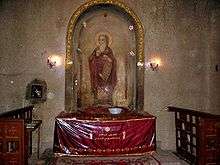Saint Mark's Coptic Orthodox Cathedral
| Saint Mark's Coptic Orthodox Cathedral | |
|---|---|
|
St. Mark's Cathedral | |
| Location | Abbassia, Cairo |
| Country |
|
| Denomination | Coptic Orthodox Church |
| History | |
| Founder(s) | Pope Cyril VI of Alexandria |
| Dedication | Saint Mark |
| Consecrated | June 25th,1968 |
| Architecture | |
| Architect(s) | Michel Bakhoum |
| Style | Coptic |
| Administration | |
| Division | The Coptic Orthodox Patriarchate |
| Clergy | |
| Bishop(s) | HH Pope Tawadros II |
St. Mark's Coptic Orthodox Cathedral is located in the Abbassia District in Cairo, Egypt. It is the seat of the Coptic Orthodox Pope. It was built during the time when Pope Cyril VI of Alexandria was Pope of the Coptic Orthodox Church and was inaugurated by him in 1968.
The cathedral is named after St. Mark the Evangelist, an apostle of Jesus and founder of the Coptic Church. Relics of his life are kept inside. It is by far the largest Cathedral in Africa[1] and the Middle East.[2]
History of the land
Historically the land where the Cathedral stands has been used for centuries as a cemetery for the Copts; this land had the historic Anba Rouis' Church.
The land had been given to the Coptic Orthodox Church in 969 by Gawhar. This land was given as a replacement for the land that was taken from the church to be included in building the Palace of Ma'ad al-Muizz Li-Deenillah as part of the planning of the new capital of Egypt, Cairo.[3]
During the twelfth century the area contained ten Coptic churches, but during the rule of Qalawun on 18 February 1280 the churches were destroyed by the persecutors of the Copts. Two churches were subsequently built in the area under the rule of his son.[3]
In 1943 the governorate of Cairo attempted to expropriate the area for public use. This was opposed by the General Congregation Council led by its secretary at the time Mr. Habib Elmasry; their campaign proved successful as the Coptic Church maintained control of the land under the condition that a non-profit building be built on it in the following fifteen years. This condition spurred the building of the cathedral.[4]
Architecture

The cathedral is considered a unique example of architectural evolution which includes seven churches of which some have a great historic value such as Anba Rouis' Church. The Cathedral represents the rapid development of Coptic architecture,[5][6] the famous Coptic civil engineer Michel Bakhoum contributed in its structural design. It has a capacity for 5,000 worshipers.[7]
Relics of Saint Mark
Before the completion of the Cathedral, the Roman Catholic pontiff of the time, Pope Paul VI, returned part of St. Mark's relics, which were stolen from Egypt in the year 828 to Venice, Italy. These relics were taken to the newly constructed Cathedral, where they were placed in a specially-built shrine brightly decorated with Coptic icons. They still remain there today.
Inauguration ceremony
The inauguration of the new Saint Mark's Coptic Orthodox Cathedral took place on June 25, 1968[8] in a ceremony attended by Egyptian President Gamal Abdel Nasser, Ethiopian Emperor Haile Selassie, among other foreign clergy members from other churches. It was the seat of Shenouda III, Pope and Patriarch of Alexandria and the See of St. Mark.
Burials

See also
- List of large Orthodox cathedrals
- St Mark's Coptic Orthodox Church (Markham) - under construction and will be the first Coptic Cathedral in North America
References
Notes
| Wikimedia Commons has media related to Saint Mark's Coptic Orthodox Cathedral, Cairo. |
- ↑ "Churches in Egypt". Egyptvoyager.com. Retrieved 2009-05-06.
- ↑ This claim can still be valid as contrary to popular belief of the largest "cathedral" being the Basilica of Our Lady of Peace of Yamoussoukro in Yamoussoukro, the administrative capital of Côte d'Ivoire (Ivory Coast), which is considered the largest church in the world but not a cathedral. The nearby Cathedral of Saint Augustine is the principal place of worship and seat of the bishop of the Diocese of Yamoussoukro.
- 1 2 "دير الأنبا رويس". Coptichistory.org. Retrieved 2012-09-28.
- ↑ St Abraam Archived June 2, 2008, at the Wayback Machine.
- ↑ "Cathedral of Abbasiya - Coptic Cairo". Memphis Tours Egypt.
- ↑ Helloegypt Archived August 16, 2007, at the Wayback Machine.
- ↑ "Old Cairo and Roda Island". Footprinttravelguides.com. Retrieved 2012-09-28.
- ↑ "Pope Saint Kyrillos VI (Cyril VI), 116th Pope of Alexandria". Zeitun-eg.org. Retrieved 2009-05-06.
Coordinates: 30°04′20″N 31°16′32″E / 30.07222°N 31.27556°E